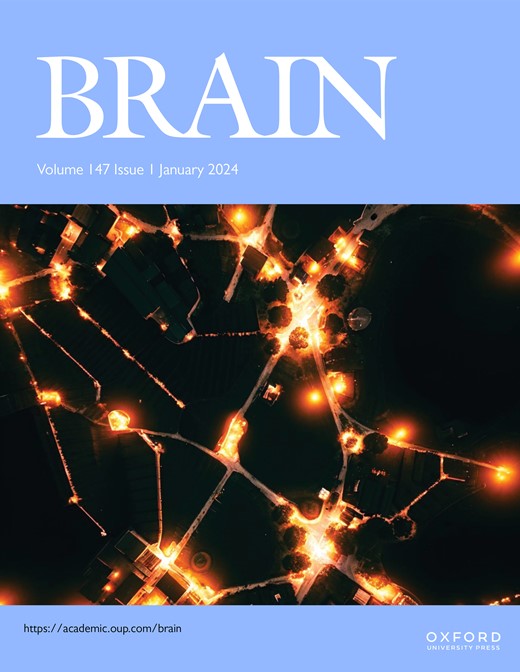Associations between accelerated forgetting, amyloid deposition and brain atrophy in older adults
IF 10.6
1区 医学
Q1 CLINICAL NEUROLOGY
引用次数: 0
Abstract
Accelerated long-term forgetting (ALF) is the phenomenon whereby material is retained normally over short intervals (e.g. minutes) but forgotten abnormally rapidly over longer periods (days or weeks). ALF may be an early marker of cognitive decline, but little is known about its relationships with preclinical Alzheimer’s disease pathology, and how memory selectivity may influence which material is forgotten. We assessed ALF in ‘Insight 46’, a sub-study of the MRC National Survey of Health and Development (a population-based cohort born during one week in 1946) (n=429; 47% female; assessed aged ∼73 years). ALF assessment comprised visual and verbal memory tests: Complex Figure Drawing and the Face-Name Associative Memory Exam (FNAME). ALF scores were calculated as the percentage of material retained after 7 days, relative to 30 minutes. In 306 cognitively-normal participants, we investigated effects on ALF of β-amyloid pathology (quantified using 18F-Florbetapir-PET, classified as positive/negative) and whole-brain and hippocampal atrophy rate (quantified from serial T1-MRI over ∼2.4 years preceding the ALF assessment), as well as interactions between these pathologies. We categorized Complex Figure Drawing items as ‘outline’ or ‘detail’, to test our hypothesis that forgetting the outline of the structure would be more sensitive to the effect of brain pathologies. We also investigated associations between ALF and Subjective Cognitive Decline, measured with the MyCog questionnaire. Complex Figure ‘outline’ items were better retained than ‘detail’ items (mean retention over 7 days = 94% vs 72%). Amyloid-positive participants showed greater forgetting of the Complex Figure outline, compared to amyloid-negatives (90% vs 95%; P<0.01). There were interactions between amyloid pathology and cerebral atrophy, such that whole-brain and hippocampal atrophy predicted greater ALF on Complex Figure Drawing among amyloid-positives only (e.g. 1.9 percentage-points lower retention per ml/year of whole-brain atrophy [95% confidence intervals 0.5, 3.7]; P<0.05). Greater ALF on FNAME was associated with increased rate of hippocampal atrophy. ALF on Complex Figure Drawing also correlated with subjective cognitive decline (-0.45 percentage-points per MyCog point [-0.85, -0.05], P<0.05). These results provide evidence of associations between some measures of ALF and biomarkers of brain pathologies and subjective cognitive decline in cognitively-normal older adults. On Complex Figure Drawing, ‘outline’ items were better remembered than ‘detail’ items – illustrating the strategic role of memory selectivity – but ‘outline’ items were also relatively more vulnerable to ALF in individuals with amyloid pathology. Overall, our findings suggest that ALF may be a sensitive marker of cognitive changes in preclinical Alzheimer’s disease.老年人加速遗忘、淀粉样蛋白沉积和脑萎缩之间的关系
加速性长期遗忘(ALF)是指在短时间内(如几分钟)材料保留正常,但在较长时间内(几天或几周)遗忘异常迅速的现象。ALF 可能是认知能力下降的早期标志,但人们对其与阿尔茨海默病临床前病理的关系以及记忆选择性如何影响遗忘材料知之甚少。我们在 "洞察 46 "中对 ALF 进行了评估,"洞察 46 "是英国皇家研究理事会全国健康与发展调查的一项子研究(1946 年一周内出生的人群)(n=429;47% 为女性;评估年龄为 73 岁以下)。ALF评估包括视觉和言语记忆测试:复杂图形绘制和面孔-姓名联想记忆测试(FNAME)。ALF分数以7天后相对于30分钟所保留材料的百分比计算。在306名认知正常的参与者中,我们研究了β-淀粉样蛋白病变(使用18F-Florbetapir-PET量化,分为阳性/阴性)和全脑及海马萎缩率(通过ALF评估前2.4年的连续T1-MRI量化)对ALF的影响,以及这些病变之间的相互作用。我们将复杂图形绘制项目分为 "轮廓 "和 "细节 "两类,以验证我们的假设,即忘记结构的轮廓会对脑部病变的影响更加敏感。我们还研究了ALF与主观认知能力下降之间的关联,并使用MyCog问卷进行了测量。与 "细节 "项目相比,复杂图形 "轮廓 "项目的保留率更高(7 天内的平均保留率 = 94% 对 72%)。与淀粉样蛋白阴性者相比,淀粉样蛋白阳性者对复杂图形大纲的遗忘率更高(90% vs 95%; P<0.01)。淀粉样蛋白病理与脑萎缩之间存在交互作用,因此仅在淀粉样蛋白阳性者中,全脑萎缩和海马体萎缩预示着复杂图形绘制中更大的ALF(例如,全脑萎缩每毫升/年降低1.9个百分点[95%置信区间0.5,3.7];P<0.05)。FNAME的ALF越大,海马萎缩率越高。复杂图形绘制的 ALF 也与主观认知能力下降有关(每 MyCog 分数-0.45 个百分点 [-0.85, -0.05],P<0.05)。这些结果证明,在认知正常的老年人中,ALF 的某些测量指标与大脑病理生物标志物和主观认知能力下降之间存在关联。在复杂图形绘制中,"轮廓 "项目比 "细节 "项目的记忆效果更好--这说明了记忆选择性的战略作用,但 "轮廓 "项目在淀粉样变性病变患者中也更容易受到ALF的影响。总之,我们的研究结果表明,ALF 可能是临床前阿尔茨海默病认知变化的敏感标记。
本文章由计算机程序翻译,如有差异,请以英文原文为准。
求助全文
约1分钟内获得全文
求助全文
来源期刊

Brain
医学-临床神经学
CiteScore
20.30
自引率
4.10%
发文量
458
审稿时长
3-6 weeks
期刊介绍:
Brain, a journal focused on clinical neurology and translational neuroscience, has been publishing landmark papers since 1878. The journal aims to expand its scope by including studies that shed light on disease mechanisms and conducting innovative clinical trials for brain disorders. With a wide range of topics covered, the Editorial Board represents the international readership and diverse coverage of the journal. Accepted articles are promptly posted online, typically within a few weeks of acceptance. As of 2022, Brain holds an impressive impact factor of 14.5, according to the Journal Citation Reports.
 求助内容:
求助内容: 应助结果提醒方式:
应助结果提醒方式:


